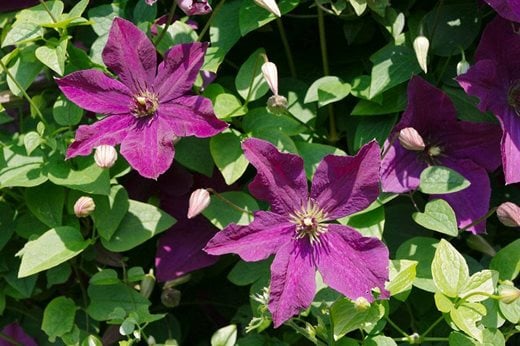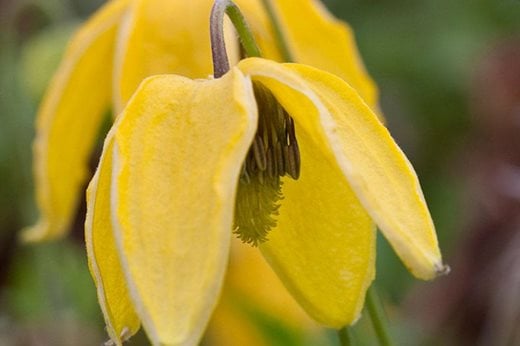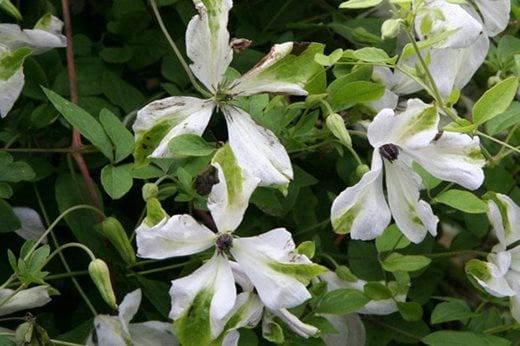Clematis are the most popular of all climbers and can be grown on walls and fences, scrambling through shrubs or even as ground cover. Plantsman Graham Rice chooses these plants with the Award of Garden Merit
This prolific and very vigorous, late-flowering Chinese species features open clusters of small, pale cream or pale yellow, bell-shaped flowers with the unusual distinction of a cowslip fragrance. Many hundreds may be open at once on a large plant, from late August or September onwards. Vulnerable to drought when young, it needs plenty of space. Prune in spring if necessary. 5-7m (16-23ft).
An extraordinary and intriguing double-flowered clematis in a rare smoky reddish purple with a paler centre where the backs of the petals, still tightly furled, are revealed. Flowering very generously from July to September, the extra weight of the double flowers demands good stout support. First seen in about 1900. Prune hard in spring. 3-4m (10-13ft).
Vivid pink, four-petalled, trumpet-shaped flowers become more flared as they mature and feature a slightly reddish bar through each petal. They open over a long season from July to October. Raised by Barry Fretwell, who also raised 'Arabella', it was originally known as 'The Princess of Wales' but renamed to avoid confusion with an older variety of the same name. Prune hard in spring. 2-2.5m (6-8ft).
 Clematis ‘Polish Spirit’
Clematis ‘Polish Spirit’
Raised in Poland in the 1980s by the well-known clematis breeder Brother Stefan Franczak, this is reckoned to be one of the easiest of all clematis to grow. Its deep purple-blue flowers, with their slightly purplish red bar and deep red anthers, open in July, August and September and a simple hard prune in spring will set it up for a prolific summer. 3-4m (10-13ft).
From the continuing clematis breeding programme of Raymond Evison, this short hybrid between a species and a large-flowered hybrid flowers from July to October. It has nodding deep violet-blue flowers becoming bluer as they age, with an intriguing twist to each of the four petals and with creamy anthers. Good scrambling through low shrubs or over a low wall. 1-1.5m (3-5ft).
A very distinctive clematis, known for the unusually bright red colouring of its flowers, with purplish overtones, and the twist that develops in the petals as they mature. Dating back to 1900 and long a favourite, this is another that is ideal for training into mature shrubs and for which the simple pruning is a hard cut back in spring. 2.5-3m (8-10ft).
 Clematis ‘Lambton Park’
Clematis ‘Lambton Park’
Large, bright yellow, four-petalled lemon-peel flowers open in late May and continue into the autumn on vigorous plants. The flowers are coconut scented and for much of its season the silvery seed heads overlap with flowering to provide an unusual, interesting season of interest. Found growing in a Durham garden centre in 1985. Prune hard in spring, but best left to scramble through a tree. 4-5m (13-16ft6in).
The one clematis almost everyone knows, its slightly nodding, four-petalled deep purple flowers open in generous numbers through July, August and September. Dating back to the mid 1860s, although this AGM plant is invaluable, it may not actually be the same as the 19th century original introduced by George Jackman which is probably lost. Prune hard in spring. 3-4m (10-13ft).
The first widely grown hybrid between a herbaceous perennial species and a large-flowered hybrid, 'Arabella' is especially known for its very long flowering season starting in June, peaking from July to September, then continuing into October. Six-petalled flowers open in deep purple-blue then lighten with age to reveal pinkish mauve veining and central bar. Prune hard in spring. 1.5-2m (5-6ft6in).
 Clematis 'Alba Luxurians'
Clematis 'Alba Luxurians'
Very distinctive in its four-petalled white flowers, each with an irregular green splash in the centre of every petal which almost disappears in full sun. This prolific variety, which has been around since about 1900, flowers from July to September and is best planted to scramble through a mature, spring-flowering shrub such as a viburnum or holly. Pruning is easy; just cut back hard early in spring. 2.5-3m (8-10ft).

